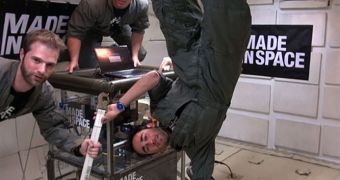Engineers at the American start-up company Made in Space (MIS) announce the successful completion of the first round of tests carried out in microgravity using three-dimensional printers. The company plans to become a major player in supplying others with solutions for space-based manufacturing.
While 3D printers are nothing, their potential for use in space exploration and colonization has largely went by unexplored. However, it is becoming increasingly clear that the trend is for space agencies and spaceflight companies to set their sights on the Moon and Mars.
As such, all those missions will require the capability to manufacture things in space, and MIS believes that its printers may be used for this very purpose. Before the company could begin to promote its merchandise, however, it first needed to test it.
In order to do that, officials at the company took advantage of an available NASA Flight Opportunities Program, which took place at the agency's Johnson Space Center (JSC), in Houston, Texas.
Researchers decided to test two printers. One of them was provided by 3D Systems, a partner of MIS and a renowned provider of 3D printing solutions. The other device was a custom-made printer.
“3D printing and in-space manufacturing will dramatically change the way we look at space exploration, commercialization, and mission design today” MIS CEO Aaron Kemmer explains. He is also the co-founder of the company.
“The possibilities range from building on-demand parts for human missions to building large space habitats that are optimized for space,” the official goes on to say. During the tests, several items were successfully printed from the two devices.
A scaled-down version of a wrench became the first-ever tool to be printed in partial microgravity conditions. At the same time, experts managed to keep material waste to a minimum. This is an often overlooked aspect of manufacturing, that is often overlooked.
In a press release, MIS says that the printers were capable of putting together complex geometries, regardless of the fact that they operated in limited gravity. The devices were also able to produce whatever components were requested of them immediately and autonomously.
“Based on past research, we already knew that 3D printing works in zero-g to some degree. The question we are answering is how well does it work,” says MIS CTO and co-founder Jason Dunn.
After engineers finish analyzing the data they collected during this test, the company plans to run even more practical simulations, in order to establish the limits 3D printers have in space. These assessments will most likely continue throughout 2012, SpaceRef reports.

 14 DAY TRIAL //
14 DAY TRIAL //